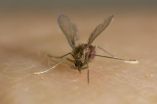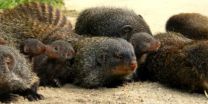(Press-News.org) This beautiful star cluster, NGC 3293, is found 8000 light-years from Earth in the constellation of Carina (The Keel). This cluster was first spotted by the French astronomer Nicolas-Louis de Lacaille in 1751, during his stay in what is now South Africa, using a tiny telescope with an aperture of just 12 millimetres. It is one of the brightest clusters in the southern sky and can be easily seen with the naked eye on a dark clear night.
Star clusters like NGC 3293 contain stars that all formed at the same time, at the same distance from Earth and out of the same cloud of gas and dust, giving them the same chemical composition. As a result clusters like this are ideal objects for testing stellar evolution theory.
Most of the stars seen here are very young, and the cluster itself is less than 10 million years old. Just babies on cosmic scales if you consider that the Sun is 4.6 billion years old and still only middle-aged. An abundance of these bright, blue, youthful stars is common in open clusters like NGC 3293, and, for example, in the better known Kappa Crucis cluster, otherwise known as the Jewel Box or NGC 4755.
These open clusters each formed from a giant cloud of molecular gas and their stars are held together by their mutual gravitational attraction. But these forces are not enough to hold a cluster together against close encounters with other clusters and clouds of gas as the cluster's own gas and dust dissipates. So, open clusters will only last a few hundred million years, unlike their big cousins, the globular clusters, which can survive for billions of years, and hold on to far more stars.
Despite some evidence suggesting that there is still some ongoing star formation in NGC 3293, it is thought that most, if not all, of the nearly fifty stars in this cluster were born in one single event. But even though these stars are all the same age, they do not all have the dazzling appearance of a star in its infancy; some of them look positively elderly, giving astronomers the chance to explore how and why stars evolve at different speeds.
Take the bright orange star at the bottom right of the cluster. This huge star, a red giant, would have been born as one of the biggest and most luminous of its litter, but bright stars burn out fast. As the star used up the fuel at its core its internal dynamics changed and it began to swell and cool, becoming the red giant we now observe. Red giants are reaching the end of their life cycle, but this red giant's sister stars are still in what is known as the pre-main-sequence — the period before the long, stable, middle period in a star's life. We see these stars in the prime of their life as hot, bright and white against the red and dusty background.
INFORMATION:
This image was taken with the Wide Field Imager (WFI) installed on the MPG/ESO 2.2-metre telescope at ESO's La Silla Observatory in northern Chile.
More information
ESO is the foremost intergovernmental astronomy organisation in Europe and the world's most productive ground-based astronomical observatory by far. It is supported by 15 countries: Austria, Belgium, Brazil, the Czech Republic, Denmark, France, Finland, Germany, Italy, the Netherlands, Portugal, Spain, Sweden, Switzerland and the United Kingdom. ESO carries out an ambitious programme focused on the design, construction and operation of powerful ground-based observing facilities enabling astronomers to make important scientific discoveries. ESO also plays a leading role in promoting and organising cooperation in astronomical research. ESO operates three unique world-class observing sites in Chile: La Silla, Paranal and Chajnantor. At Paranal, ESO operates the Very Large Telescope, the world's most advanced visible-light astronomical observatory and two survey telescopes. VISTA works in the infrared and is the world's largest survey telescope and the VLT Survey Telescope is the largest telescope designed to exclusively survey the skies in visible light. ESO is the European partner of a revolutionary astronomical telescope ALMA, the largest astronomical project in existence. ESO is currently planning the 39-metre European Extremely Large optical/near-infrared Telescope, the E-ELT, which will become "the world's biggest eye on the sky".
Links
* Photos of the MPG/ESO 2.2-metre telescope: http://www.eso.org/public/images/archive/search/?adv=&subject_name=mpg
* Other photos taken with the MPG/ESO 2.2-metre telescope: http://www.eso.org/public/images/archive/search/?adv=&facility=15
* Photos of La Silla: http://www.eso.org/public/images/archive/category/lasilla/
Contacts
Richard Hook
ESO education and Public Outreach Department
Garching bei München, Germany
Tel: +49 89 3200 6655
Email: rhook@eso.org
Lives and deaths of sibling stars
2014-07-23
ELSE PRESS RELEASES FROM THIS DATE:
When it comes to depressed men in the military, does size matter?
2014-07-23
Los Angeles, CA (July 23, 2014) Both short and tall men in the military are more at risk for depression than their uniformed colleagues of average height, a new study finds. This study was published today in the open access journal SAGE Open.
Despite the researchers' original hypothesis that shorter men in the military would be more psychologically vulnerable than their taller counterparts, researchers Valery Krupnik and Mariya Cherkasova found that men both shorter and taller than average by one standard deviation may be predisposed to higher rates of depressive disorders. ...
Controlling childbirth pain tied to lower depression risk
2014-07-23
CHICAGO --- Controlling pain during childbirth and post delivery may reduce the risk of postpartum depression, writes Katherine Wisner, M.D., a Northwestern Medicine® perinatal psychiatrist, in a July 23 editorial in Anesthesia & Analgesia.
Wisner's editorial is based on a new Chinese study that found women who had pain control with epidural anesthesia during a vaginal delivery had a much lower risk for postpartum depression than women who didn't have the epidural.
"Maximizing pain control in labor and delivery with your obstetrician and anesthesia team might help ...
Life expectancy gains threatened as more older Americans suffer from multiple conditions
2014-07-23
With nearly four in five older Americans living with multiple chronic medical conditions, a new study by researchers at Johns Hopkins Bloomberg School of Public Health finds that the more ailments you have after retirement age, the shorter your life expectancy. The analysis, one of the first to examine the burden of multiple chronic conditions on life expectancy among the elderly, may help explain why increases in life expectancy among older Americans are slowing.
A report on the findings, based on an analysis of 1.4 million Medicare enrollees, appears in the August issue ...
Knowledgeable consumers more likely to buy when given fewer options
2014-07-23
The degree to which consumers perceive themselves to be knowledgeable about a product influences the likelihood that they will buy a particular product, researchers find in a series of studies published in Psychological Science, a journal of the Association for Psychological Science.
"Together, our findings suggest that subjective knowledge may play an important role in determining ideal size for choice sets," explains researcher Liat Hadar of the Arison School of Business at the Interdisciplinary Center Herzliya in Israel. "That is, more options should be provided in ...
Benefits of combo lipid emulsion no greater than soy-based emulsion for pediatric patients
2014-07-23
Lipid emulsions are crucial for providing essential fatty acids and energy to infants and children who need intravenous feeding. There has been concern that soybean-based emulsions could compromise immune functions and promote liver damage due to its composition. Combination lipid emulsions based on triglyceride oil, fish oil, or olive oil have been developed to address this concern.
However, researchers at Rutgers and Tufts universities found that concern may be unwarranted, according to a review published today in the OnlineFirst version of the Journal of Parenteral ...
Largest genetic survey to date shows major success of giant panda breeding programs
2014-07-23
Heroic worldwide conservation efforts have made great strides in saving China's endangered national treasure, the giant panda. Now, in China, there are over 65 giant panda reserves that have been established and three large breeding centers. But despite these efforts, just 1596 pandas remain in the wild.
Breeding programs in conservation centers and zoos hope to save the panda by improving genetic diversity, avoid inbreeding and ultimately, introduce pandas back to the wild. Just how are these high-profile programs doing so far?
In a new study appearing in the advanced ...
The human parasite Leishmania is a probiotic for the fly that carries it
2014-07-23
The Leishmania parasite, which causes the human disease leishmaniasis, acts as a probiotic in the insect that transmits it to humans, protecting them from bacterial disease. Findings published in the open access journal Parasites and Vectors suggest that using bacterial controls to stop the spread of leishmaniasis could sometimes have the opposite effect to that intended, by benefiting flies carrying the parasite.
Around 12 million people are currently infected with leishmaniasis worldwide, mostly in South America, Africa and Asia. It is estimated to kill 20-50,000 people ...
Stress can make hard-working mongooses less likely to help in the future
2014-07-23
Researchers studying banded mongooses in Uganda have discovered that those who work hard to care for pups may be less likely to invest in future offspring in the same way due to elevated stress hormones.
Dr Jennifer Sanderson, from the University of Exeter, has been observing wild banded mongooses to understand why working hard makes them less likely to work hard in the future.
She discovered that when a banded mongoose invests heavily to care for mongoose pups, it experiences an increase in circulating stress hormones (or 'glucocorticoids'), and these high stress ...
New model helps explain how provisions promote or reduce wildlife disease
2014-07-23
Athens, Ga. – Scientists have long known that providing supplemental food for wildlife, or resource provisioning, can sometimes cause more harm than good. University of Georgia ecologists have developed a new mathematical model to tease apart the processes that help explain why. Their research, which has implications for public health and wildlife conservation, appears in the Royal Society journal Biology Letters.
Wildlife of many kinds are increasingly finding their meals in human environments, gathering at places like backyard bird feeders, landfills or farms that offer ...
In asthma, it's not just what you smell, but what you think you smell
2014-07-22
PHILADELPHIA (July 22, 2014) – New research from the Monell Center reveals that simply believing that an odor is potentially harmful can increase airway inflammation in asthmatics for at least 24 hours following exposure. The findings highlight the role that expectations can play in health-related outcomes.
"Asthmatics often are anxious about scents and fragrances. When we expect that an odor is harmful, our bodies react as if that odor is indeed harmful," said study lead author Cristina Jaén, PhD, a Monell physiologist. "Both patients and care providers need to understand ...


